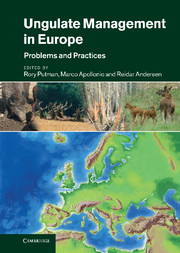Book contents
- Frontmatter
- Contents
- List of contributors
- Scientific names of species referred to in this text
- 1 Introduction
- 2 Status and distribution patterns of European ungulates: genetics, population history and conservation
- 3 A review of the various legal and administrative systems governing management of large herbivores in Europe
- 4 Hunting seasons in relation to biological breeding seasons and the implications for the control or regulation of ungulate populations
- 5 The census and management of populations of ungulates in Europe
- 6 Impacts of wild ungulates on vegetation: costs and benefits
- 7 Wild ungulate diseases and the risk for livestock and public health
- 8 Traffic collisions involving deer and other ungulates in Europe and available measures for mitigation
- 9 Large herbivores as ‘environmental engineers’
- 10 Ungulate–large carnivore relationships in Europe
- 11 The role of pathogens in the population dynamics of European ungulates
- 12 Climate change and implications for the future distribution and management of ungulates in Europe
- 13 Ungulate management in Europe: towards a sustainable future
- Index
- References
5 - The census and management of populations of ungulates in Europe
Published online by Cambridge University Press: 26 April 2011
- Frontmatter
- Contents
- List of contributors
- Scientific names of species referred to in this text
- 1 Introduction
- 2 Status and distribution patterns of European ungulates: genetics, population history and conservation
- 3 A review of the various legal and administrative systems governing management of large herbivores in Europe
- 4 Hunting seasons in relation to biological breeding seasons and the implications for the control or regulation of ungulate populations
- 5 The census and management of populations of ungulates in Europe
- 6 Impacts of wild ungulates on vegetation: costs and benefits
- 7 Wild ungulate diseases and the risk for livestock and public health
- 8 Traffic collisions involving deer and other ungulates in Europe and available measures for mitigation
- 9 Large herbivores as ‘environmental engineers’
- 10 Ungulate–large carnivore relationships in Europe
- 11 The role of pathogens in the population dynamics of European ungulates
- 12 Climate change and implications for the future distribution and management of ungulates in Europe
- 13 Ungulate management in Europe: towards a sustainable future
- Index
- References
Summary
Introduction
Over recent decades managers have had to cope with populations of ungulates which have substantially increased both their range and density in Europe (see Apollonio et al.,2010, and references therein). In fact, of the 20 different species of free-ranging ungulates in Europe, only fallow deer Dama dama populations have remained comparatively stable in the last decades. This situation has been perceived by some people as a positive change, leading to greater opportunities for observation of native ungulates by the general public, as well as increased opportunities for those interested in hunting. Unfortunately this marked change in status also has some drawbacks where there is perceived to be an increase in ungulate–human conflicts. Ungulates may cause significant damage to farming and forestry (see Chapter 6 this volume), collisions with vehicles (see Chapter 8), and the spread of disease (Simpson, 2002; Chapter 7 this volume). In addition, there is a growing concern that large populations of ungulates may have a substantial effect on ecosystem function (e.g. Danell et al., 2006). Consequently, in many countries society considers that managers should control ungulate populations through hunting in order to meet specific management objectives (Sinclair, 1997). In practice, the management of most populations of ungulates consists of setting harvest quotas for hunting.
- Type
- Chapter
- Information
- Ungulate Management in EuropeProblems and Practices, pp. 106 - 143Publisher: Cambridge University PressPrint publication year: 2011
References
- 26
- Cited by

